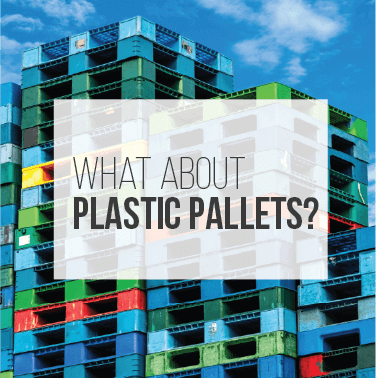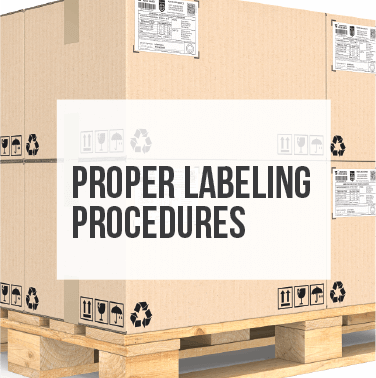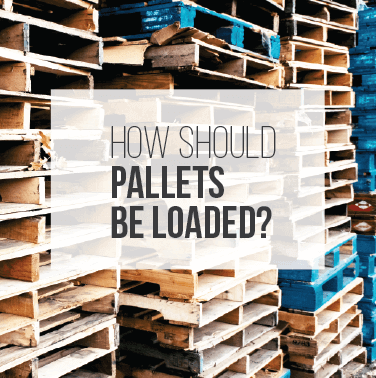Shipping goods overseas is a dream come true for many businesses. However, with international shipments come rules and regulations you will need to follow. If you intend to ship freight across the border, there are several international pallet requirements you’ll need to know.
The most important international requirement you need to follow is making sure your pallets are heat treated. For safety purposes, your pallets should be no higher than 60 inches and no wider than 96x125 inches. Pallets should also have two or more exact duplicate shipping and warning labels placed on their various sides.
In this guide, you will find detailed requirements that need to be followed when using pallets for international transport.
Wood that is being shipped internationally must be fumigated or heat treated. This includes wood packaging materials such as pallets, crates and dunnage. This is a requirement regardless of what method is used to transport the pallets.
The reason that this requirement is in place is because of something called ISPM - 15 or the International Standards for Phytosanitary Measures No. This measure was created by an organization called the International Plant Protection Convention (IPPC).
The purpose of ISPM - 15 is to prevent the spread of pests and diseases that could potentially be traveling in solid wood materials. Under ISPM - 15, wood packaging material must be heated until its internal temperature is 56 degrees celsius (132.8 degrees Fahrenheit) or higher. The wood packaging materials must remain at or above that temperature for 30 minutes.
There are many different ways that wood can be heated to this temperature. The common way is through heat treatment. Not only is it the standard method for the industry, but it’s also the most effective and environmentally friendly.
Other heating options include:
The most important part of the heating process comes at the very end. Once the wood has finished being heated, it is given a stamp or branding that has the IPPC's internationally recognized mark. This mark indicates that the wood packing material has been treated and the country has approved it.
Wood that is engineered, like plywood, hardboard and oriented standard wood, are exempt from ISPM-15. Before you put your wood packing materials through heat treatment, check to make sure they’re not made of wood that is exempt from this requirement.
If you are using pallets to ship commercial goods, it is essential they go through heat treatment and receive this stamp.

While wood remains a popular choice in the shipping industry, you can use plastic pallets if you choose. There are many benefits to be reaped from using plastic pallets.
For one, plastic pallets won’t require you to follow the same wooden pallet requirements for international shipments. This means you won’t have to follow the ISPM-15 heat treatment protocol.
One added benefit of using plastic pallets is that they typically last longer than wood pallets. Plastic pallets are durable which allows them to perform well in different environments.
While plastic pallets have their benefits, they also come with some downsides. When it comes to expenses, you will be spending more on plastic pallets than wooden ones. However, paying more for plastic pallets might seem worth it since they last longer.
Pallets cannot hold up freight that has a total weight of 1,500 pounds or more. Any damage that pallets do sustain cannot be repaired. They will either have to be melted down and recycled or remodeled into a new pallet.

There are multiple types of labels that you will need to put on your international shipment of pallets. The most important label that you should include is the shipping label.
This shipping label should include the following information on it:
Depending on what you are shipping on your pallets, you might want to place labels that give specific directions on how your freight should be handled. You can include labels that say “do not double stack” or “this side up” and other warnings and directions as needed.
Directions and warnings will help warehouse workers handle your palletized freight efficiently. Labels like these can also prevent any potential damages to the freight itself.
If your freight can’t be moved while it is secured to a pallet, then include labels that will help workers lift it. This includes labeling the center of gravity for the freight as well as lifting points.
Having exact duplicates of labels placed on different sides of your international shipment of pallets is essential. At the least, you want to have two duplicates of every label you use.
Pallet labels can be blocked from view by the walls of shipping containers or by other shipping pallets next to them. Having duplicate labels on multiple sides of your shipments will increase the likelihood that workers and forklift operators will see them.

The Occupational Safety and Health Administration (OSHA) gives a fairly vague description as to how pallets should be loaded. OSHA simply states that pallets should be loaded in a way that prevents them from sliding or collapsing.
Despite this suggestion, there is no set international standard for how your pallets should be loaded. However, there are a few techniques to stacking pallets that will prevent damage to your freight and injury to workers handling it.
The very first thing you should do is make sure that the pallet(s) that you plan on using are in good shape. Pallets are your foundation and using one with compromised integrity could potentially damage your goods.
Begin stacking the heaviest freight you have onto the pallet first. By placing heavier freight onto the pallets first, you create a base for the rest of your freight to be loaded on. Having heavier freight on the bottom of the pallet will prevent lighter freight from being damaged.
Another way to prevent your freight from being crushed is by making sure the individual boxes are packed properly. Properly sizing the packages to the goods they carry will minimize the amount of space in them.
While having a small amount of space in your boxes is okay, you don’t want to have too much. If your boxes have too much space you should utilize some type of cushioning material. Cushioning materials that you could use are:
Freight should be stacked evenly onto the pallets. This means that your freight should not be stacked like a pyramid and freight should not be hanging off the pallets.
The next step after stacking your freight onto a pallet is securing it using either straps or wrapping. Securing freight to a pallet using strapping will require multiple straps.
Typically, using four straps will allow you to effectively secure freight to a pallet. Have two of the straps run vertically along the length of your freight while the other two are secured perpendicular to the load.
The two straps that run vertically should wrap around your freight and your pallet. The straps should not be wrapped around an area of the pallets that can be damaged by the forks of the forklift.
Wrapping your freight follows a similar process to stacking freight. When you begin wrapping, start at the base of the pallet and gradually work your way up the freight.
It's important to note that the pallet should not be overwrapped. That is because a forklift will still need to be able to stick its forks underneath the pallet.
Once you reach the top of your stacked freight, overlap the wrapping so that the top will be covered. Afterward, wrap the center and bottom of your stack just a few more times.
As you wrap your freight, be sure to keep firm and tight pressure. If the freight of your international shipment is too loose it could move around during its journey.
Once you have finished wrapping your palletized freight, cut off any wrap you don’t need. What’s left of your wrapping will be tied to one of the corners on the pallet.
The safest maximum height for freight that is secured to a pallet is 60 inches, or five feet. The reason this height is optimal is because it allows you to load a considerable amount of freight while also preventing it from being too high.
Freight that is too high can be unsafe for the freight itself and any workers handling it. Extremely tall stacks of freight can become unstable and tip over. Additionally, freight that exceeds this height becomes considerably harder to strap down and wrap.
Pallets come in various types of widths. While there is no set limit to the width your pallets have to be, we do recommend that they are at a width of 96 by 125 inches or under.
For more tips on what not to do when you ship, check out our article on 12 common shipping mistakes. It will go over some accidents that happen often in the shipping industry.
Want to know more about shipping pallets to large companies? Read our articles on Amazon pallet requirements and Walmart pallet requirements.
Following pallet requirements for international shipments requires a good amount of due diligence. At R+L Global Logistics we can handle all of those requirements for you.
Over the years of being in business, we have helped customers move all kinds of shipments domestically and internationally. Our goal at R+L Global Logistics is to exceed your expectations when we transport your goods.
We form lasting relationships with many of our customers because of the superior services that we offer. With a 99.5 percent on-time rate, you can trust that your goods will get where they need to be prompt.
If you’re ready to ship with us, navigate to our truckload freight page to get your quick and easy shipping quote today.
R+L Global Logistics
315 NE 14th St., Ocala, FL 34470